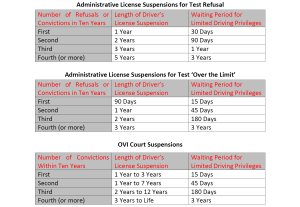 I came across an article about a pending bill in South Dakota which proposes expanding the scope of driving privileges for people convicted of DUI (called ‘OVI in Ohio). It reminded me that, in Ohio, driving privileges related to OVI are often misunderstood. This article clarifies Ohio law regarding limited driving privileges and describes how driving privileges work in practice.
I came across an article about a pending bill in South Dakota which proposes expanding the scope of driving privileges for people convicted of DUI (called ‘OVI in Ohio). It reminded me that, in Ohio, driving privileges related to OVI are often misunderstood. This article clarifies Ohio law regarding limited driving privileges and describes how driving privileges work in practice.
Ohio Driver’s License Suspensions Related to OVI
In Ohio, there are two types of driver’s license suspensions related to Operating a Vehicle Under the Influence (OVI).
First, if a person is arrested for OVI and either refuses to submit to an alcohol/drug test or takes a test and produces a result ‘over the limit’, the Bureau of Motor Vehicles imposes an Administrative License Suspension (ALS). The length of the suspension depends on the number of times the person has refused a test and/or has been convicted of OVI in the past ten years.
Second, if a person is convicted of OVI, the court imposes a license suspension as part of the sentence. The length of the court suspension depends on the number of times the person has refused a test or has been convicted of OVI in the past ten years.
Ohio Law for Limited Driving Privileges
For both an ALS and a court suspension, Ohio law authorizes courts to grant limited driving privileges. Before 2004, Ohio law authorized driving privileges only for employment purposes. In 2004, the law was revised to permit driving privileges for additional purposes: educational, vocational, medical, and court-ordered treatment.
In 2016, the scope of driving privileges in Ohio Revised Code section 4510.021 was expanded to include, “any other purpose the court determines appropriate”. In practice, however, most courts do not permit driving for all purposes. The scope of driving privileges for OVI-related suspension depends heavily on what court grants the privileges.
Obtaining Limited Driving Privileges
To obtain limited driving privileges on an ALS or a court suspension, a person must file a motion or application. There is a waiting period for filing the motion. The waiting period depends on the circumstances and may be as little as 15 days or as much as three years. The motion or application states the reasons for which the person is requesting to drive, as well as the days and times for which driving privileges are requested. If the court grants the motion, the court issues an entry. The entry states when, where, and for what purposes the person is permitted to drive.
Using Limited Driving Privileges
When a person is granted limited driving privileges, the person must carry the entry with them when they drive. The person is not given a driver’s license; only a paper entry. Many courts also require the person to carry with them a driving log and proof they are driving for an authorized purpose. In some cases, the person is required to drive a vehicle equipped with an ignition interlock device and/or restricted (yellow) license plates.
If a person with a driver’s license suspension is stopped by a law enforcement officer, the officer will check the person’s driver’s license status using the Law Enforcement Automated Data System, so the officer will know the driver has a license suspension. The driver must then show the officer the limited driving privileges entry, driving log, and proof they are driving for an authorized purpose. The driver must be able to convince the officer they are driving in compliance with their limited driving privileges.
Penalties for Violating Terms of Driving Privileges
If an officer is not convinced a driver is driving in compliance with their limited driving privileges, the officer will likely issue the driver a ticket for Driving Under an OVI Suspension. According to Ohio Revised Code section 4510.14, that offense is categorized as a first-degree misdemeanor. The punishment includes a jail term of three days to six months, a driver’s license suspension for up to one year, a fine of $250 to $1,000, and immobilization of the vehicle for 30 days. If the person has prior convictions for this offense within the last six years, the penalties increase.
 Columbus OVI/DUI Attorney Blog
Columbus OVI/DUI Attorney Blog

